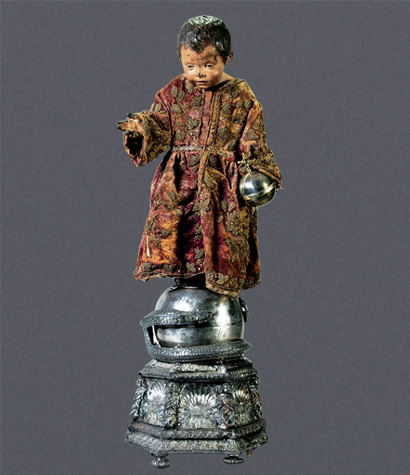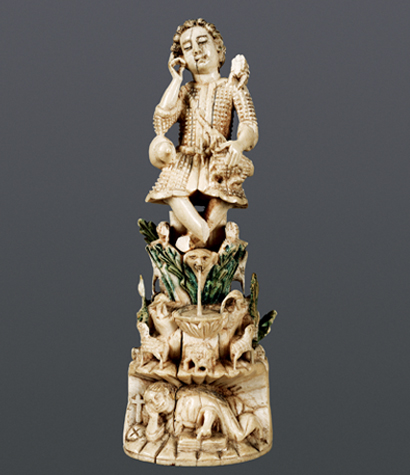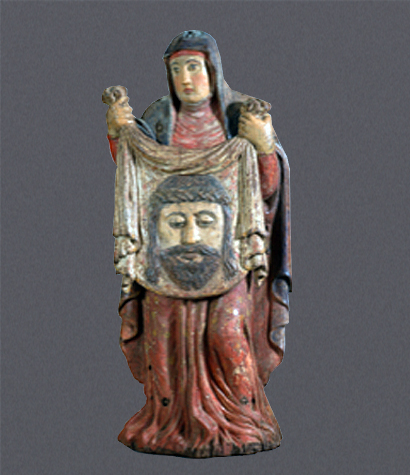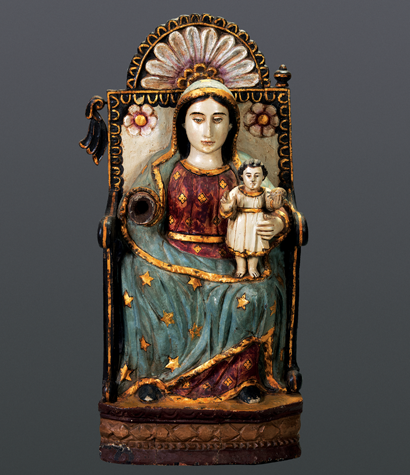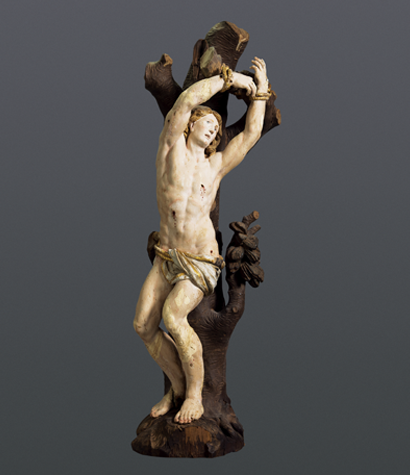
This large sculpture of St. Sebastian is a luminous example of Indo-Portuguese art in its realism and aesthetic achievement. An early Christian saint and martyr, Sebastian (256-268 CE) was a Roman soldier of distinction, killed for his faith by Emperor Diocletian (284-305 CE).
The saint is Italianate in appearance, with his body, though in polychrome on wood, seeming to be hewn out of marble or ivory. It is a body of great Apollonian beauty, that of a muscular young man in his prime (he was only 32 when he was killed). The artist seems to have employed even the wood’s natural grain to emphasize this muscularity. St. Sebastian is European in aspect, with blond hair; his originally pale eyes were outlined in black perhaps at a later time, for it was common to repaint images. The body is well proportioned, and hands and feet are naturalistic. The saint wears a white loincloth trimmed with gold, and secured by a gold cord. Its flowing appearance and the visible cord show Baroque influence, the latter a new artistic representation of that period. The saint’s hands are bound with rope to a tree, with the sculpture capturing the moment right after he was shot at by the emperor’s archers. On his body are reddish traces of the arrow wounds. Though the saint survived this attempt to kill him, being later clubbed to death, it grew customary to represent him in such a manner, especially after 1000 CE, leading to the popular misconception about how he was martyred.
Still retaining most of its original beauty, the sculpture displays damage at some places, and where the paint has flaked off, has been repainted in shades of a hue yellower than before. The stylized tree, suggestive of the Indian almond, has lopped branches, with one small branch carrying thick leaves whose leathery greenness can be imagined, and perhaps partially open fruit. The spreading shape of the tree can also be imagined, and along with the stylized horizontal ridges on the bark that follow the curve of the trunk, and the design of the leaves, anticipate the great Indian artist from Goa, Mario Miranda, in whose work similar indigenous trees are seen.
St. Sebastian was the patron-saint of the plague-ridden, and an important figure after the Black Death (1347-51) in Europe, as he later came to be in epidemic-stricken Old Goa. The many sculptures of this saint in the museum’s collection testify to his popularity. In Graeco-Roman myth, the archer god Apollo both shot his enemies with plague-arrows and saved his people from pestilence; St. Sebastian Christianizes this myth.
NOTES
In 1986, Mario Miranda was the chief impetus behind the present Museum, wanting to preserve and protect for posterity works of Indo-Portuguese sacred art, recognized for their great artistic, historical and cultural value.
PUBLICATIONS
Museum of Christian Art, Convent of Santa Monica, Goa, India, Calouste Gulbenkian Foundation, Lisbon, 2011.


